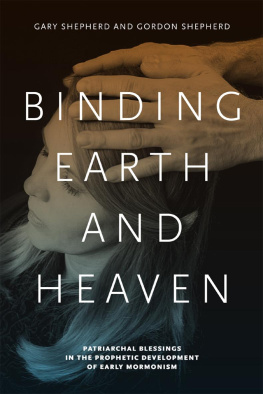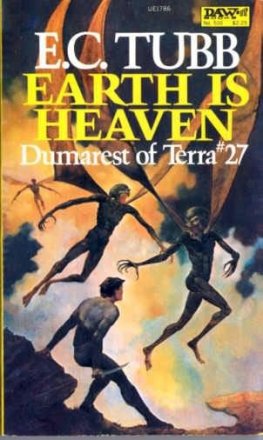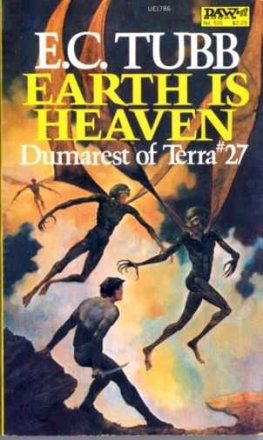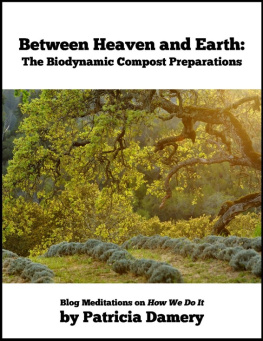Library of Congress Cataloging-in-Publication Data Shepherd, Gary, 1943
Binding earth and heaven : patriarchal blessings in the prophetic development of early Mormonism / Gary Shepherd and Gordon Shepherd.
p. cm.
Includes bibliographical references and index. Summary: Focuses on Mormonism as a case study of how unpopular new religions may survive and even flourish in spite of unrelenting opposition. Examines early patriarchal blessings bestowed upon early converts to Mormonism from 18341845, and their function as a commitment mechanism for convertsProvided by publisher.
ISBN 978-0-271-05633-3 (cloth : alk. paper)
1. Patriarchal blessings (Mormon Church).
2. Church of Jesus Christ of Latter-day Saints History19th century.
3. Mormon ChurchHistory19th century.
I. Shepherd, Gordon, 1943. II. Title.
BX8643.p36S54 2012
264.09332013dc23
2012020544
Copyright 2012 The Pennsylvania State University
All rights reserved
Printed in the United States of America
Published by The Pennsylvania State University Press,
University Park, PA 16802-1003
The Pennsylvania State University Press is a member of the Association of American University Presses.
It is the policy of The Pennsylvania State University Press to use acid-free paper. Publications on uncoated stock satisfy the minimum requirements of American National Standard for Information SciencesPermanence of Paper for Printed Library Material, ANSI Z39.48-1992.
This book is printed on Natures Natural, which contains 30% post-consumer waste.
CONTENTS
The Commitment and Doctrinal Functions of
Early Mormon Patriarchal Blessings
The Problems and Promise of Patriarchal Blessings
as Historical Artifacts
APPENDIX A: Examples of Oracular Versus Inspirational Modes
of Prophetic Rhetoric
APPENDIX B: Blessings Randomly Sampled from
Marquardts Early Patriarchal Blessings
PREFACE
In this book we explore several ways in which the unique Mormon theory and practice of issuing patriarchal blessings contributed to the early development of Mormonism as an ultimately successful new religious movement, in spite of widely held perceptions that the Mormons constituted a heretical religious and social menace. Mormon patriarchal blessings were an innovative adaptation of the Old Testament practice of fathers making quasi-legal pronouncements over the heads of their sonsa way of verbally conferring rights and promises, admonition and guidance, to heirs. They were introduced as a restored practice by Mormonisms founder, Joseph Smith, about three years after he formally incorporated his church in 1830. By 1835, Smith had greatly expanded the theological significance of these blessings and connected them to a divinely legitimated priesthood office: the office of church patriarch. He also expanded the blessing recipient category to include all faithful members of the church, male and female. Thereafter, large numbers of Mormons living in proximity of the holder of this office avidly sought out a blessing from the ordained Patriarch. The theological and organizational complexities of this practiceand especially its contributions to strengthening and sustaining member faith and fealty, bolstering the continuity and development of Mormonism as a new religionare elaborated in the chapters that follow.
We do not, however, propose in this book to write a detailed narrative of the institutional history of the office and duties of LDS Church Patriarchs in the full context of Mormon history. To an impressive degree, this has already been accomplished by Irene Bates and E. Gary Smith in their book Lost Legacy: The Mormon Office of Presiding Patriarch. Nor do we intend to painstakingly document the gradual modification of the mode and thematic content of blessings issued to church members from the 1830s until the present day. We simply do not have the necessary documentary data for that purpose. Instead, our focus is on the first decade of the institution of patriarchal blessings, from 1834 to 1845, a concentrated and dramatic period of Mormon history that preceded the division of the Latter-day Saint community in Nauvoo, Illinois, and the embarkation in 1846 of Mormon pioneersunder the leadership of Brigham Youngto the Rocky Mountains of the American West.
Having said this, it is still possible for us to make some broad comparisons of early patriarchal blessings with those bestowed and cherished by Mormons today, which we summarize in the final chapter of this book.
We would like to make one final observation about the approach we take in this book as academic sociologists. Social science teaches that the institutions of any society, including religious institutions, are formed and changed through meaningful human interaction. Alternatively, we may simply say that all human institutions are socially constructed. The province of social science is the naturalistic analysis of how the organization and patterns of human life are socially negotiated and agreed upon, the problems that human communities confront in this process (including the modification and fracturing of agreements), and the consequences that ensue for both individuals and group culture.
If there be extra-human agency or supernatural powers ultimately involved in the human construction of history and society, it is not, strictly speaking, the province of social science to judge and determine their ontological authenticity. More specifically, it is not the province of social science to validate or invalidate the ultimate truth claims of religious faith. For this we must turn to metaphysics or theology and to a consideration of the various religious epistemologies employed by seekers of transcendent meaning. While methodologically agnostic with respect to transcendent causes and ultimate meanings, social science analysis can nonetheless contribute significantly to our understanding of the human aspects of religious institutions and religious ways of life.
We are indebted to Michael Marquardts superior scholarship in assembling the large collection of Smith patriarchal blessings, which constitutes the basis of our empirical analysis for this book, and for his suggestion to us that we carry out this analysis in the first place. We are grateful to Michael Quinn for an early, helpful critique of a portion of what emerged as our book; to Jan Shipps for early encouragement to pursue this project and subsequent endorsement of it; to Armand Mauss for his suggestions and strong support of our manuscript when it was undergoing critical review; and to Lavina Fielding Anderson for sharing advanced versions of her own parallel patriarchal blessing research accompanied by valuable insights and recommendations concerning ours. We also are grateful for the various contributions of Gordons three daughters: Natalie arduously coded the blessing contents, Lynne posed and photographed the image on our books cover, and Pam lent her layout expertise. Finally, we acknowledge and applaud the professional competence of The Pennsylvania State University Press. In particular, Kendra Boileau displayed assiduous editorial guidance and maintained her faith in our project even when we briefly lost ours. Laura Reed-Morrisson performed superb plastic surgery on the text and helped us craft a much cleaner final version. Jennifer Norton was open to suggestions and then worked with Jason Harvey to design the striking book cover, and Brian Beer was flexible and efficient in generating publicity. Any errors of fact or interpretation in the book are, of course, ours.












